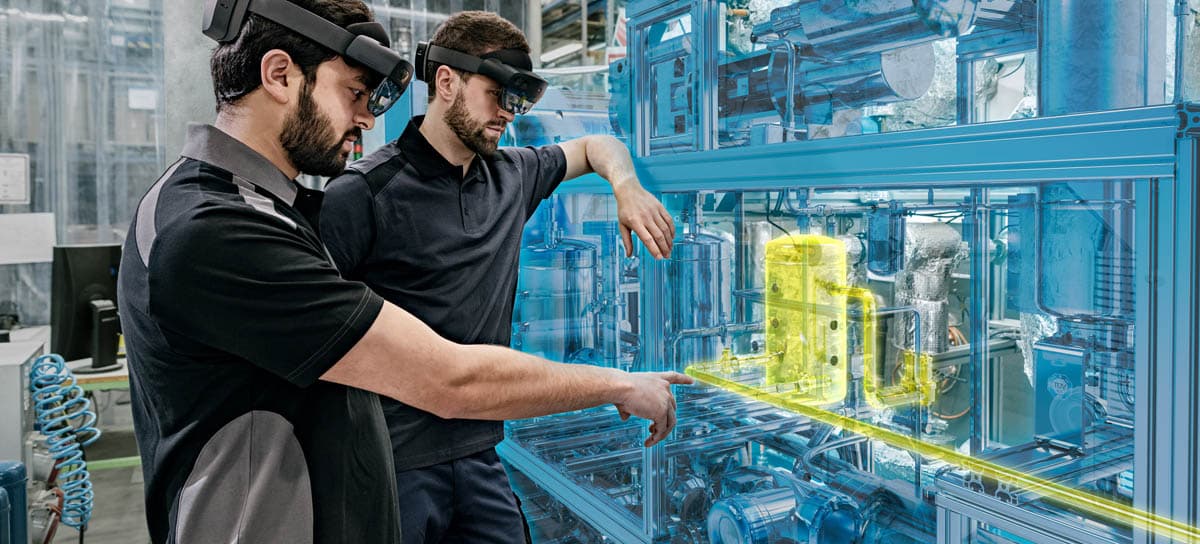Smart Maintenance - How to make your maintenance fit for the future
Smart maintenance is one of the most important application scenarios of Industry 4.0. After all, with the right digital tools, companies can extend the service life of machinery and equipment and operate them much more cost-effectively.
So far, however, only a minority of German companies use smart maintenance. According to Digitization Index it is just 21 percent.
In this article, we explain what is behind the buzzword smart maintenance, what advantages smart maintenance offers, and how companies can introduce smart maintenance and become Smart Factories become smart maintenance.

Smart Maintenance: What is it?
In view of digital innovation and global competition, productivity pressure is also increasing in industry – and with it the demands on the Maintenance and Remote maintenance . Quality and flexibility are to be improved, costs and time saved. This is where Smart Maintenance comes into play.
Smart Maintenance - Definition
In Industry 4.0, smart maintenance refers to all technical and organizational measures aimed at using digital tools to make maintenance and servicing more efficient and contribute to greater value creation for the company.
The core of Smart Maintenance is the collection and linking of data from machines, plants or buildings. The technical infrastructures will be equipped with sensors that continuously measure their functionality and performance and forward the data to digital applications, in the best case a central application platform. This results in various possible uses.
This might also interest you:
- Maintenance software : What you should pay attention to
- Augmented Reality : Opportunities for the industry
Smart Maintenance: Examples from corporate practice
Because smart maintenance applications keep a permanent eye on key machine performance variables, they detect abnormalities and wear earlier than humans can. They report abnormalities via alert to employees, who can then carry out necessary maintenance measures without delays.
In some cases, smart maintenance applications can also regulate machines fully automatically to prevent malfunctions. If sensors detect critical temperatures in motors, for example, the software throttles the power independently and thus prevents a failure.
So far, however, smart maintenance is still far from replacing human employees. The main application is in support maintenance.
With the help of intelligent applications, companies can collect huge amounts of data, evaluate it, and thus identify potential for process optimization. One example: MRP planning. Instead of planning according to fixed intervals, maintenance managers can assess the condition of machines more accurately and base their planning on this, thus eliminating many deadlines and saving costs.
Read appropriately:
- Workflow Automation : How companies automatically achieve more
You want to learn more about the different maintenance concepts?
A number of companies still use paper-based documents on which maintenance staff document their work. They have to manually enter the results into the IT system after their shift, which costs unnecessary time and carries the risk of errors. Here, too, smart maintenance can ensure greater efficiency by replacing analog processes with digital ones.
Employees carry their work instructions and checklists with them on a tablet or can access them via Smart Glasses access to them at all times. This not only prevents media disruptions. Maintenance staff can retrieve important information from other systems with a click or voice command in the event of a problem, without having to leave their place of work.

AR glasses: Smart Maintenance with the HMT-1
AR glasses are one of the underrated productivity boosters in maintenance. In the industrial environment, augmented reality glasses have become HMT-1 from Realwear proven. The rugged data goggles have been certified to IP66 and MIL-STD-810, meaning they can withstand extreme temperatures and drops from heights of up to two meters.
In our Shopt you can find the data goggles from Realwear also with Atex certification. Here the HMT-Z1 discover
The HMT-1 can be easily combined with the usual protective equipment such as hard helmets and goggles and offers a particularly large field of vision.
What the AR glasses do? You can use it like a tablet connected to your central data management system. However, the control is carried out via voice commands. Files and documents are displayed directly in the field of view or virtually inserted into the environment.
Possible functions:
- Video telephonyMaintenance staff can make brief arrangements without interrupting their work on the machines and receive support at any time, for example from supervisors or colleagues.
- Remote maintenance: If the glasses are operated with remote maintenance software maintenance staff can observe and guide customers live via the camera of the glasses while solving small problems.
- Documentation: Documents and checklists can be called up and filled in by voice command.
- IoT data visualization: Work steps can be visualized and data analyses can be superimposed on the field of view.
- Mobile time recording: Instead of working with paper lists, tablets or terminals, employees can record their working hours via AR glasses. It doesn’t get any more convenient than this.
The HMT-1’s battery lasts up to eight hours, so employees can use it during a work shift without interruption.
AR glasses or Head Mounted Displays are a simple tool, but they massively increase productivity in maintenance. Because their big advantage compared to other mobile devices: They can be operated hands-free.
Maintenance staff no longer have to interrupt their work to take a look at their tablet, but can be supported in real time via image and sound during their work. This can result in time savings of up to 25 percent per employee per week.
And instead of having to match images on a monitor with reality, AR glasses superimpose the next action steps directly into the environment. Errors are thus reduced to practically zero.

7 convincing advantages of Smart Maintenance
There are many ways to optimize production plants and systems using digital applications. However, the benefits of Smart Maintenance are always the same:
- Minimized downtime for machinery and equipment
- Reduced (personnel) costs for maintenance and servicing
- Optimized workflows
- Longer runtimes and higher productivity of technical equipment
- Higher flexibility in the production system
- Higher innovation capability
- Higher added value
Smart Maintenance is the key for industrial companies that want to transform themselves in a future-proof way and it is the basis for using upcoming Industrie 4.0 technologies profitably.
What is Predictive Maintenance?
Predictive maintenance goes one step further than smart maintenance. It is the counter design to the previous reactive maintenance.
Predictive maintenance applications are based on artificial intelligence (AI). The applications’ AI algorithms can use historical sensor data or real-time data to predict potential problems at facilities and take preventive countermeasures. Companies can also determine the remaining service life of plants and plant components and display the effects of changes, for example in the intensity of use.
In addition, predictive maintenance applications are able to calculate optimal maintenance times based on functional data. The tests are then no longer carried out at a fixed interval, but only when it is really necessary from a functional point of view – an enormous cost saving.
Artificial intelligence makes smart maintenance a learning-oriented maintenance: By employees giving the system feedback on the quality of its forecasts, it continuously learns and can improve the efficiency and longevity of the production system more and more.
According to a study by the German Federal Ministry of Economics companies that use AI technologies can increase their profits by around 25 percent.

Introduction: Lean Smart Maintenance
The introduction of smart maintenance and predictive maintenance is without alternative for industrial companies if they want to hold their own in the market in the future. But the introduction is demanding. It doesn’t just affect IT. Smart maintenance must be understood as a holistic organizational transformation.
Companies should therefore plan the introduction as a step-by-step process. One concept that has proven helpful for the transformation to the smart factory is Lean Smart Maintenance .
The scientifically based maintenance approach not only aims at cost efficiency, but also takes into account market developments that demand increasing flexibility and agility from companies.
Two elements are therefore combined in Lean Smart Maintenance:
- LEAN approach for more effectiveness
- SMART approach for more efficiency
The aim is to anchor Smart Maintenance throughout the company in such a way that it contributes to increasing value creation.
Lean Smart Maintenance is implemented and optimized in a continuous cycle of four steps: Plan, Do, Check, Act.
Plan – Set goals
First, companies should define monetarily measurable goals to be achieved with smart maintenance. In addition to direct costs, indirect costs such as downtime follow-up costs should also be taken into account when calculating the value contribution of smart maintenance.
Do – Implement measures
This is followed by the gradual introduction of digital tools that support employees in maintenance and servicing. Depending on the digital maturity of the organization, monitoring systems to prevent failures and predictive maintenance applications can be introduced.
Check – Check successes
This is followed by a ratio-based evaluation of the measures: What value contribution was achieved? Where are the weak points? How can the potential of digital applications be better exploited?
Act – Initiate improvements
Companies are adapting their strategy and organization to become smart factories thanks to smart maintenance. They train employees so that they develop the necessary know-how to apply the new strategies and technologies.
More success through Lean Smart Maintenance is possible for every industrial company. Value creation arises from the changed role that maintenance takes on. It is evolving from a preserving and reactive maintenance to an acting, preventing and improving entity.
Smart Maintenance: Growing Success Factor in the Industry
The future of industry lies in the smart factory, and smart maintenance is a central component of this.
So far, Smart Maintenance as an element of Industry 4.0 is still not very widespread in companies in German-speaking countries, but reports on innovation leaders show its potential. The sooner companies start embracing modern technologies, the greater their competitive advantage.
Although the digital transformation of maintenance is a process that takes years, initial successes with smart maintenance can be achieved quickly. Particularly manageable pilot projects are suitable for getting started, for example with AR glasses. In this way, companies collect positive reference values, management backing is strengthened, and employees’ willingness to embrace new processes and technologies grows. Companies can then build on this momentum to let further innovation follow.
Want to learn more about the benefits of smart maintenance and the use of augmented reality in industry? Then call.
